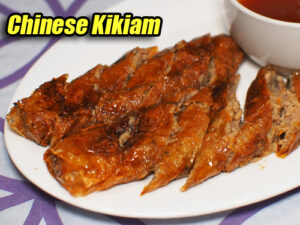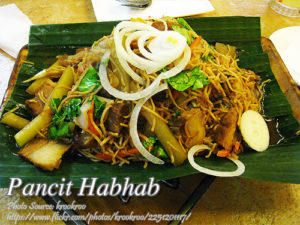Lomi Batangas recipe is a Batangas version of your favorite lomi where there are no veggies or if there is any, it is only used as garnishing. This is a version of lomi created for meat lovers where the most of the ingredients aside from the miki noodles are pork meat, pork liver, pork rind or chicharon, kikiam and fried pork belly for garnishing.
But some of these dishes vary in their garnishing like adding squid balls or fish balls on top of the kikiam. I also notice the use of the thickening agent where some use cornstarch and others use cassava starch. But if you want your lomi to have a clear soup (of course the color would be brown because of the soy sauce), use sweet potato starch just like the one used in making maki mi.
Lomi Batangas: A Hearty, Meaty Twist on a Filipino Classic
This lomi has a special place in my heart, and for good reason. It’s not your typical noodle dish; this particular version from Batangas focuses less on veggies and more on satisfying chunks of pork, liver, and chicharon, making it a must for meat lovers. Growing up, I remember my Tita Linda making it for us during rainy days, and the memory of those cozy meals stuck with me. Unlike other lomi versions, which sometimes come packed with cabbage, carrots, and all kinds of greens, Batangas-style lomi keeps it straightforward and meaty, with just a bit of garnish for that added touch.
If you’re curious about this dish or want to make it yourself, let me take you through how to cook lomi Batangas, along with a few family tips passed down from Tita Linda and Kuya Romy. They’ve spent years perfecting this recipe, so I can promise you’re in for a treat.
The Story and Origins of Lomi Batangas
Lomi first made its way to the Philippines through Chinese immigrants and gradually became a staple across the country. However, Batangas made its own mark with a unique take on this noodle soup. Where other versions might prioritize a mix of vegetables, Batangas’ version zeroes in on rich, hearty pork. The ingredients tell a story of resourcefulness, focusing on available meats and creating a dish that is filling, savory, and unapologetically indulgent.
In Batangas, lomi is considered the ultimate comfort food. It’s something people crave after a long day, and it’s often shared with family or friends. It’s not unusual to see a bustling lomi house with big, steaming bowls of this meaty soup on every table. Some say that the appeal lies in its simplicity; others attribute its charm to the unmistakable richness of the broth. Either way, it has found its way into the hearts (and bowls) of many Filipinos.
Preparing the Perfect Broth: The Heart of Lomi Batangas
When it comes to making an authentic lomi Batangas, the broth is where all the flavor starts. In our family, Kuya Romy taught us to use pork broth whenever possible, simmering the bones long enough to release a full-bodied flavor. If you’re using water instead, you can substitute with pork bouillon cubes, but pork broth will give you a depth that really elevates the dish.
In a hot wok, start by sautéing garlic and onions until the onions turn soft. This base alone adds a delicious aroma that makes the entire house smell amazing. Once the onions are softened, add in the pork meat and fry it until golden brown and crispy around the edges. It’s a step that might seem simple, but it gives the broth a rich flavor and satisfying texture. When the pork liver is added, sauté it briefly, letting it brown without overcooking—just enough to retain that slightly earthy taste which blends beautifully with the pork. Seasoning with fish sauce and soy sauce ties these flavors together, layering the broth with a savory base before you pour in the broth and let it simmer.
Noodles and Thickeners: Why Cassava Starch Works Best
In lomi Batangas, the noodles are just as crucial as the broth. Miki noodles, with their thick and chewy texture, are ideal for holding onto the soup’s rich flavors. These noodles don’t turn mushy and keep their bite even after a good amount of cooking, making every spoonful hearty and filling.
The thickening agent is a little trick my Lola Elena shared with us. Some recipes call for cornstarch or even sweet potato starch, but for a true Batangas feel, she recommends using cassava starch. Not only does cassava starch provide a subtle thickness, but it also keeps the broth from getting cloudy, unlike cornstarch which can sometimes dilute the flavors. Adding the cassava starch slurry slowly while stirring helps maintain the soup’s smooth texture, giving it that perfect consistency Batangas lomi is known for.
Adding the Finishing Touches
Once your broth has thickened, the beaten egg comes in, adding an extra layer of richness to the soup. Tita Linda always says that the egg is what makes the broth creamy and ties everything together, and I couldn’t agree more. Pour it in slowly while stirring, ensuring it spreads evenly throughout the soup, creating those lovely, silky ribbons in the broth.
The final step is what brings it all home: garnish. Crushed chicharon, crispy kikiam, and spring onions are sprinkled on top, bringing both flavor and texture to each bite. Some variations add squid balls or fish balls, but our family likes to keep it classic. And no lomi Batangas experience is complete without a side of soy sauce, calamansi, and red chili peppers for dipping. This condiment mix adds a tangy, spicy kick that balances the richness of the soup perfectly.
Why Lomi Batangas Is the Ultimate Comfort Food
For beginners, making this iconic lomi might sound a bit intricate, but don’t let that stop you. Once you get the hang of the steps, it’s straightforward. Every ingredient has a purpose, and the layering of flavors—from the pork broth to the liver, to the seasoned noodles—is what makes this dish so comforting and satisfying.
Lomi Batangas isn’t just food; it’s a piece of Batangas culture served in a bowl. It’s a dish that resonates with locals and Filipinos around the world who long for that familiar taste of home. Whether you’re cooking it for the first time or it’s a family favorite, each spoonful brings with it warmth, comfort, and a reminder of why simple, hearty meals like this one have stood the test of time.
So grab a bowl, pour yourself some lomi, and savor every bite. And who knows—maybe you’ll be passing this recipe down to the next generation, too.
How to Cook Lomi Batangas
Ingredients
- 500 grams miki noodles
- 5 cloves garlic minced
- 1 onion chopped
- 100 grams fried kikiam sliced
- 150 grams pork belly sliced into thin strips
- 3 Tbsp. cassava flour diluted in 3 Tbsp. water
- 100 grams pork liver sliced
- 1 1/2 Tbsp. fish sauce patis
- 1 Tbsp. soy sauce
- 8 cups pork broth or water
- 1 pc pork cube optional if using pork broth
- 1/2 tsp. ground black pepper
- 1 piece raw egg beaten
- 2 Tbsp. spring onion chopped
- 2 Tbsp. cooking oil
- 1 cup chicharon crushed (for garnishing)
- or 1/2 cup chopped fried pork for garnishing
Instructions
How to cook Lomi Batangas:
- In a wok, heat some cooking oil and saute garlic and onion until the onions are soft. Add the pork and stir fry until brown and crispy. Add the pork liver and saute again for a minute. Season pepper and stir. Then pour fish sauce and soy sauce and stir until it mixed well with the meat.
- Pour the pork broth and bring to a boil. If you are using water instead of pork broth, add the pork cubes. Then simmer until the pork is tender for about 20 minutes.
- Add the miki noodles and stir cook for about 6 minutes. Adjust the seasoning with salt and pepper if necessary. After cooking the noodles, pour the cassava starch slurry and stir cook in low heat until the sauce thickens.
- Add the beaten egg in the soup and stir until the eggs are evenly distributed. Turn off heat and serve in a bowl and garnish with crushed chicharon, kikiam and spring onions. Serve with the mixture of soy sauce, kalamansi and red chili peppers.
Video
Notes
Cooking Tips:
Choosing the Right Cut of Pork
For the best flavor and texture, use a mix of pork cuts including belly, shoulder, and liver. The pork belly provides a rich, fatty flavor while the shoulder adds a tender, meaty texture. Adding liver enhances the dish with its unique, savory depth.Perfecting the Soup Consistency
To achieve the ideal thickness, dissolve cassava starch in a small amount of cold water before adding it to the soup. Stir continuously to prevent lumps and ensure the starch is evenly distributed. For a clearer broth, use sweet potato starch instead of cornstarch.Enhancing Flavor with Garnishes
Top your lomi with freshly crushed chicharon, kikiam, and spring onions for added crunch and flavor. For an extra kick, serve with a side of soy sauce mixed with kalamansi juice and red chili peppers. This combination of garnishes elevates the dish, making each bowlful more exciting and flavorful.






Do i use the same
measurement if i’m using cornstarch?
Hi Danice,
Yes you can use the same amount.
Pede po ba gamitin corn flour instead of cassava flour?
HI Mirasol, pwede rin flour pero mas ok cornstarch kasi medyo transparent yung cornstarch kesa flour pag naluto na.
Hi Sheila, I’m sure you are going to love this recipe!
I missed this lomi batangas and I’m going to make this tonight! Thanks for the recipe.